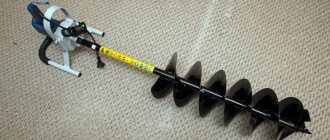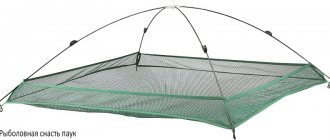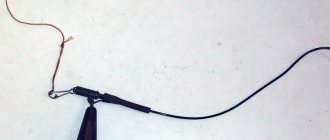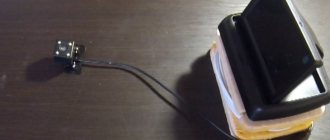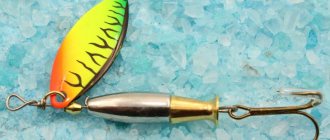Winter fishing is a passionate hobby that captivates you immediately and forever. Once they fall in love with this type of leisure, fishermen remain faithful to it, despite the cold and the dangers that lie in wait for this difficult activity.
Experienced fishermen experience incomparable pleasure from winter fishing, receiving, in addition to the excitement of hunting and the joy of catch, quiet unity with nature and relaxation in the fresh air.
It is a mistake to think that these “unfortunate” people, when exposed to cold, windswept ice for a long time, freeze “to the bone.”

Nowadays, a huge number of ways have been invented to keep warm even in conditions of complete immobility. These are thermal underwear, special shoes and overalls with special impregnation that do not give the slightest chance to cold air, and in case of very severe frosts and bad weather, fishing enthusiasts set up tents for winter fishing, many of which are made with their own hands.
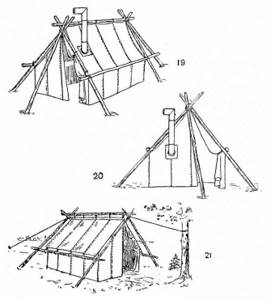
What should a tent be like?
Making such a shelter yourself does not require effort, although it protects from adverse weather conditions no worse, and sometimes better than a purchased one, while saving money.
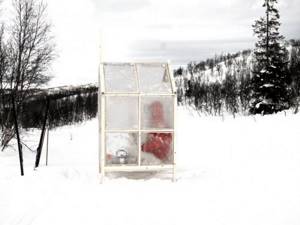
In the manufacture of such structures, the craftsman’s own requirements for the size and weight of the product, the speed of its assembly, the ability to protect from cold, the possibility of insulation and the installation of additional equipment are taken into account.
To retain heat, therefore, to cover it, use a material that has good strength, thermal insulation, moisture resistance, but at the same time has breathable properties.
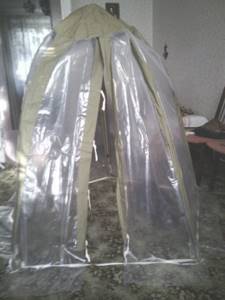
Be lightweight, mobile, compactly folded, and quickly installed. Frames made of aluminum or composite materials meet these requirements.
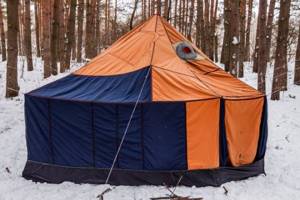
Types of tents
There is a wide variety of options for homemade winter tents, which are used both in summer and winter. The choice of design depends on the method of ice fishing.
For stationary fishing, a frame structure is installed in one place. Lightweight mobile models that can be quickly assembled are mainly used for walking fishing.
According to their design and assembly methods, tents are divided into the following types:
- Umbrella . The simplest design, which in its structure resembles an umbrella. For the frame, duralumin tubes and rods are used, which have a high level of strength. On top it is covered with an awning, which is made of synthetic fabrics or tarpaulin. This design can be quickly assembled and installed.
- Automatic . The canvas of the model is connected to the frame, so during the assembly process it is quite simple to unfold it. The frame, thanks to the spring mechanism, is able to take the required shape in a few minutes. Such models are relatively light in weight and easy to use. However, they have a significant drawback - an unstable frame. The structure can bend under gusts of wind and can easily break if transported incorrectly.
- Frame . The product is assembled by hand from several tubes or arcs fastened together, made of duralumin and fiberglass. An awning is pulled over the frame from above. Using this principle, models of any size and shape are assembled - trapezoid, triangle, cube. You can quickly build a reliable and stable structure with your own hands.
Making your own tent
When deciding how to make a tent with your own hands, there is no need to be afraid that special knowledge or skills will be required.
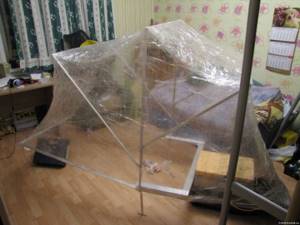
Frame assembly
To make the frame, metal tubes or even ski poles are used as supports. They are connected using fastening hinges and installed directly on skis or other available materials.
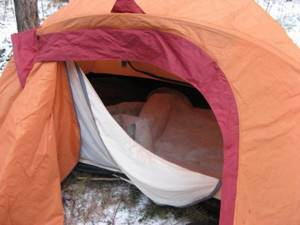
Note!
- A nod for do-it-yourself winter fishing - how and what to make good gear from. 115 photos and video tips from the pros!

Do-it-yourself spinners - types, features of homemade spinners and their assembly (100 photos and videos)
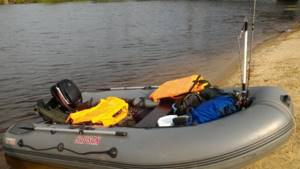
How to minimize fishing costs? Useful tips from experienced fishermen and an overview of current solutions (65 photos)
Manufacturing of coating
In order not to make a mistake with the size of the awning, a drawing with preliminary calculations is first made. On its basis, a pattern is created from the desired fabric.
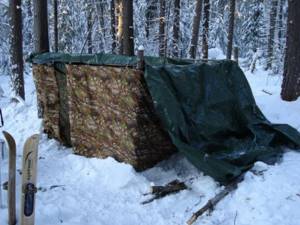
Be sure to add at least two centimeters for seam allowance. To avoid sagging, the dome is secured with eyelets, reinforced if necessary with reinforced tape.
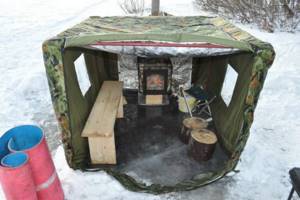
DIY making
Making and assembling a tent for a fisherman includes several important steps.
Frame installation
A rigid collapsible frame is assembled from several main and additional side supports, for which aluminum ski poles, metal or plastic tubes are suitable. The parts are connected using three-way and corner hinges and special tubes. The frame can be installed on a sled made from skis and other available materials using special tube fasteners.
Creation and fastening of an awning
To make an awning, the product drawing is carefully calculated in accordance with the required dimensions. The finished pattern is cut from water-repellent fabric with a two-centimeter seam allowance. The attachment points for installing the dome are secured with eyelets; they are reinforced with reinforced tape on the plastic film.
To secure the structure, screws are most often used. For a do-it-yourself winter tent, such fastenings are made from a metal rod and self-tapping screws. A piece of rod is welded to a long self-tapping screw in the form of a handle. To make it more convenient to handle screwdrivers in the cold, rubber or silicone tubes are placed on the rod.
Threaded hooks, pegs, etc. can also be used as fastening elements.
Making the floor
To make fishing in comfortable conditions, you can make a floor. Isolon (polyethylene foam), a sheet insulation material with high thermal insulation properties, is well suited for these purposes.
A piece of appropriate size is cut out of a sheet of insulation and holes for holes are made in it. Such flooring perfectly retains heat inside the shelter. The ice underneath does not melt even when using the oven.
Creating Fasteners
To fix the shelter on the ice, screws are usually used, which you can make yourself using metal rods and self-tapping screws.
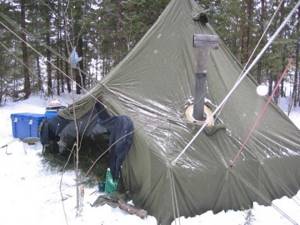
Using hooks or pegs driven into the ice as fasteners is also acceptable, but not very convenient.

House for winter fishing
Winter fishing is an extreme activity: frost, high humidity, piercing wind blowing across the expanses of the reservoir, frozen fishing line, which you have to untangle only with your bare hands. Not everyone can withstand such tests.
- But there are other conditions: a cozy, warm house located directly above the hole, a kettle warming up on the stove, and even beds.
- Accustomed to steadfastly enduring all hardships and hardships, fishermen of the old school can snort contemptuously: they say, these are not our methods, what pleasure is there in such fishing? But there are also quite a few adherents of comfort. A tent can be called a transitional step to “warm” fishing, but it has a number of significant disadvantages.
- In strong winds it has to be further strengthened; when it thaws, water sloshes under your feet. And, most importantly, the tent cannot be quickly moved to a hole located some ten meters away. A winter fishing house is free of these shortcomings.
Overview of the winter house
The invention of mobile houses is claimed by the Americans, but such devices have long been in use among residents of our villages located in close proximity to water bodies.
Homemade structures come in a wide variety: from lightweight plywood houses on skids, designed to be moved by hand, to massive, well-equipped structures in which you can spend several days on the pond.
But what about residents of megacities who simply have nowhere to keep such a house? And it is not designed for long journeys. There is a solution: you can make a folding house for winter fishing with your own hands.
When disassembled, it takes up minimal space, can be transported on the roof or in the trunk of a car, and can be assembled on site in a matter of minutes.
Handicraftsmen make various versions of houses, both for themselves and to order. This is what one of them looks like.
- The base is a plywood sheet of the FK or SFK brand, 6 mm thick and 180x130 cm in size (of course, the dimensions may be different). This is the floor of the future “cottage”. Ski racks are attached to the bottom, providing a clearance of 25 cm, and the skis themselves are attached to them. All connections are hinged, which allows you to quickly disassemble and assemble the structure.
- In addition, the racks provide the ability to install the house above the hole in a raised or lowered position. The choice of position depends on weather conditions. Access to the holes is provided through hatches in the floor. The frame for the walls, roof and door is made of wooden blocks, treated with an antiseptic and painted to protect against moisture.
- All connections are also made on hinges. Spacers are installed along the perimeter of the roof and the ridge. Then the whole thing is covered with thick fabric, and the end walls are covered with transparent polycarbonate for lighting. The mobile house for winter fishing is ready. All that remains is to equip it inside. The collapsible table, bench and chairs are made of plywood.
- When folded, they are small in size and easy to transport.
Potbelly stove in the house
A small stove-stove, powered by wood or diesel fuel, will complement the “interior”. Hot water is useful for more than just making tea. It is convenient for her to melt ice in freezing holes. The house can accommodate up to 3 people at the same time, and one of them is provided with a sleeping place.
Transportation and storage of the house
For transportation, the “building” is folded into a “pancake” measuring 180x130x15 cm. To do this, you just need to remove the spacers. The weight of the house is about 20 kg, and even alone it is not difficult to load it onto the roof of a car.
- If the structure needs to be dragged over a considerable distance across a body of water, it does not have to be loaded onto a car, but you can use skis. When folded, the house can be easily stored in a garage or shed.
- However, if there is neither one nor the other, and the square footage of the apartment is small, then even such a small item can cause some inconvenience.
- You can get out of this situation by making a house of a similar design, but not with a solid floor, but with a folding floor made from several pieces of plywood connected with hinges. When folded, it is a box that can easily fit in the trunk of a car.
- In working condition, the house is similar to the first option, but disassembly takes a little more time: 15 - 20 minutes. You can come up with quite a lot of options for a collapsible bottom and, in the end, achieve the desired size.
- A folding house for winter fishing can be made using other technologies. The video shows the assembly of a house consisting of 6 foam panels: a floor, four walls and a roof.
The design is extremely simple, but it can also protect the fisherman from the cold.
Source: https://myriba.ru/masterskaya-rybaka/domik-dlya-zimnej-rybalki.html
Floor construction
To create more comfortable conditions, you can build a floor for a winter tent with your own hands. This simple work will ultimately help reduce heat loss and, as a result, save on heating the structure.
Note!
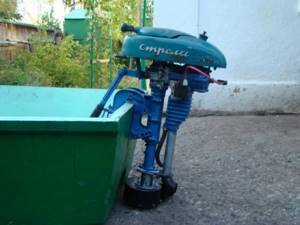
Do-it-yourself boat motor - tips for beginners, projects, drawings and step-by-step description of the construction of the main components and elements (video + 120 photos)
Feeder for winter fishing - secrets of use and techniques for feeding fish in winter (115 photos)
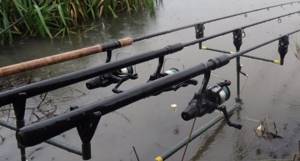
Bottom gear - the most effective types of equipment and features of casting techniques (95 photos and videos)
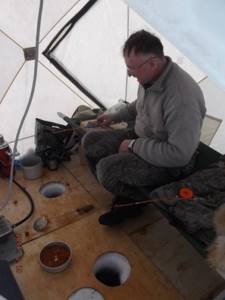
The material for making the floor can be any thick insulation, for example, isolon. When using foil insulation, it is folded in half with the foil facing out, which allows you to retain heat for a longer time and avoid melting ice when using heating appliances.

Tent heating
The main requirement for heating devices is low fire hazard and no waste.
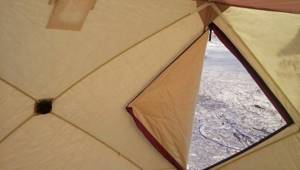
In this case, you can use special industrial devices: gas burners or mobile mini-ovens, or you can heat a winter tent with your own hands using scrap materials.
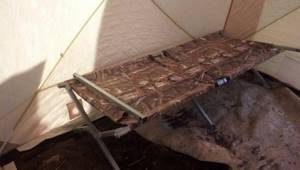
This is done using:
Hot water in a large closed container, covered with a thick cloth to enhance the effect. Its action lasts for several hours.
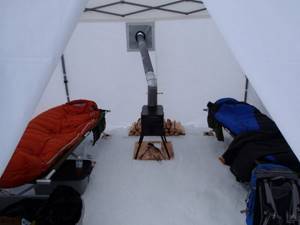
Tourist candles. With low heating efficiency, even one candle can increase the temperature inside a small shelter by several degrees.

However, fire safety is required here; for this, candles are placed inside cans or other objects that insulate from fire.

Hot stones or hot sand. To reduce the rate of heat loss, a large stone is wrapped in foil and placed on an insulating base. For the same purposes, but without foil, small stones or sand are used.

The considered methods heat the tent in mild frosts and for a short time.

In conditions of severe frosts and many days of staying on ice for a winter tent, it is better to build a stove with your own hands, which will provide long-term heating of the structure and prevent freezing of the holes located inside.
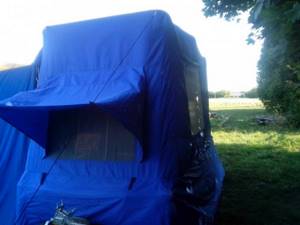
Requirements for a homemade tent
The main purpose of the tent is to create favorable conditions for fishing in snowy or windy weather. In addition, there is a place where it is more convenient to cook food, drink tea and warm up using special heating devices.
You can, of course, buy such a tent (especially since the choice is huge now), but it’s better to make it yourself. When sewing yourself, you need to pay special attention to the following points:
- The tent should be light, compact and mobile, since it has to be carried over long distances when choosing a place to fish.
- The fabric selected is dense. It is better if it is waterproof (for example, tarpaulin).
- The tent should be quick to set up and easy to set up.
- It is not recommended to use plastic material to make the frame, but the aluminum frame is quite durable.
- The tent should be warm.
There are different tent designs. The most common are three varieties:
- An umbrella-shaped tent is made using aluminum rods or tubes. Any synthetic fabrics are suitable for awning covering (combined use in combination with tarpaulin is sometimes possible). The result is a fairly rigid and durable structure.
- Automatically changing tents are less common than umbrellas. The peculiarity of this design is the ability to roll the fabric sewn to the frame into a circle.
- A tent with a frame in the form of 2-3 arcs made of duralumin or fiberglass, which unfold on the spot. Then an awning is pulled over them.
The geometric shape of the tent can be any: triangular, trapezoidal, sphere or cube. It all depends on the taste of the fisherman himself.
Parts for a homemade tent
The parts that will be needed to make a tent can be taken from available materials:
- a pair of the smallest children's skis or school skis (up to 1.6 m long);
- duralumin tubes (you can use ski poles);
- old unnecessary folding bed;
- awning waterproof fabric.
Making a homemade fishing tent
You can assemble the structure in the following sequence:
- A frame made of aluminum ski poles is mounted in two steps: first, vertical posts are installed, and horizontal tubes (thinner than vertical ones) are attached to them. The top of the tent is assembled from tees ending in cylinders 5 cm long. The diameter of the cylinders should be the same as that of the joining tubes.
- The lower ends of the vertically arranged tubes are attached to the skis. There is a T-shaped tab at the bottom of the tube. It needs to be inserted into a metal plate that is attached to the ski. The tube is then rotated 90 degrees.
- The tent frame is connected to the box. To do this, use two tubes from an unnecessary folding bed, bent at the ends. A docking product is attached to one end, and a latch is installed at the other end. It is this that, when docked, gets its tongue into the hole on the other bent tube.
- The connection of the box with the tubes occurs using strips made of steel or copper attached to the racks.
- Tensioning of the awning is possible due to metal plates with slots installed on the lower edge. U-shaped brackets pass through them, which must be driven into the side ends of the skis. The connections are secured using shoe laces.
- Setting up a tent is possible using two anchors - penknives with a double-sided blade.
To increase comfort in a homemade tent in winter, various devices are used. One of them is a special tent floor. It is better to make such flooring from a material with low thermal conductivity (for example, polyethylene foam) no thinner than 15 mm.
The selected floor thickness is determined by two requirements.
- Firstly , this way you can protect yourself from melting ice under your feet.
- Secondly , at temperatures above 20 degrees below zero, the floor will add comfort.
When fishing in a tent in winter, there is a need to heat the interior space. Resourceful fishermen obtain warmth using homemade or commercial heating devices. The use of candles is advisable at temperatures up to 15 degrees below zero.
If it is colder, then this method is ineffective and will not allow you to warm up the space inside the tent.
The use of dry fuel is possible even with the use of homemade stands made from tin cans.
However, when dry fuel is burned for a long time, large amounts of carbon monoxide are released. In this regard, you have to frequently ventilate the tent, and this is unlikely to help retain heat.
There are also a variety of heating devices that run on natural gas or solid fuel. Just keep in mind that these devices are quite bulky and heavy. They can only be used if they are delivered to the reservoir by car.
- In fact, there are a great variety of different tent designs, and there is a wide field for imagination. The shape of a fishing shelter can be absolutely any: both round and acute-angled. The design is selected based on the capabilities and availability of necessary materials.
- The main thing to keep in mind is its lightweight design and compact appearance when disassembled.
- After all, it should be possible to carry it manually over a long distance when searching for a fishing spot on a pond. When setting up a tent, pay attention to which direction the wind is blowing.
The tent must be positioned so that the exit and ventilation holes are on the side perpendicular to the wind.
Source: https://pike-fish.ru/snaryazhenie/palatka-svoimi-rukami-dlya-komfortnoj-rybalki.html
Furnace for winter shelter
Any beginner can create homemade stoves with a wide variety of shapes and sizes.
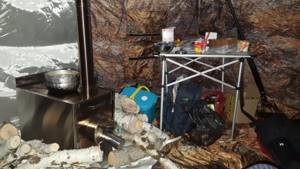
The most primitive and popular design is made from an ordinary tin can and is not inferior in functionality to industrially produced models.
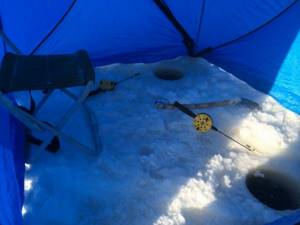
To make it, in addition to the jar, you will need:
- a metal mug, the diameter of which is 1 cm less than the diameter of the jar;
- spare parts from an old TV antenna;
- fastening material;
- a piece of tin sheet.
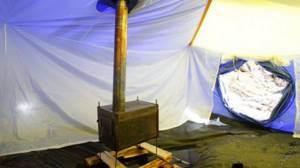
Having collected the necessary parts, you can begin assembly:
A circle with a diameter of 3 cm is cut out of a tin sheet. It is divided into three segments, bent at an angle of 90 degrees, forming petals.
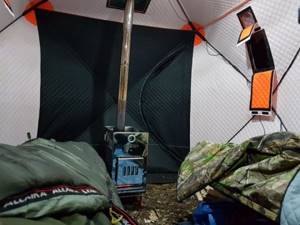
Regarding the position of the petals, three holes are made in the bottom of the jar, matching in size with the tips of the petals.
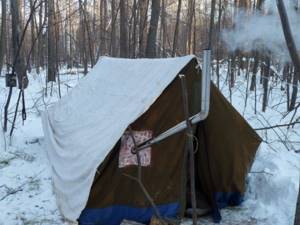
The circle is fixed on the bottom of the jar due to the petals that fall into the corresponding grooves. Its surface is intended for fuel.
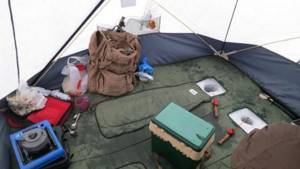
At a distance of 2-2.5 cm from the top edge of the jar, three holes are drilled for the nuts on which the mug is secured.
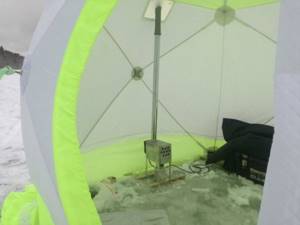
Slots are made in the bottom of the structure for legs made from parts of an old antenna; their size should not exceed the diameter of the mug.
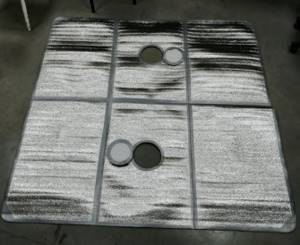
For the lid of the structure, you can use another tin can, cut appropriately and tightly fitting to the top of the stove.

Several more holes are scrolled along the entire bottom of the product, located at an equal distance from each other.

Such a device, despite its unpresentable appearance, does an excellent job of heating a tent, and with a little improvement, heating food.

The main stages of manufacturing the structure
In previous sections, we have already looked at how to cut the base for a tarpaulin tent. Now let’s look in more detail at how best to sew a product so that it can withstand strong gusts of wind and not get wet in the rain (Figure 6).
To strengthen the tent structure, follow these instructions:
- All panels are sewn together with a double seam. To further strengthen its edges, it is advisable to coat it with rubber glue. This is guaranteed to protect the interior of the shelter from moisture penetration.
- A pre-washed braid should be secured to the ridge. In this case, it will not shrink and will serve as the basis for a reliable roof.
- Any stripes that are on the surface of the awning must be sewn along the edges, capturing both the fabric and the loop. This will provide a reliable connection and at the same time protect the awning from moisture.
- It is advisable to provide a ventilation hole with a sleeve in the rear wall.
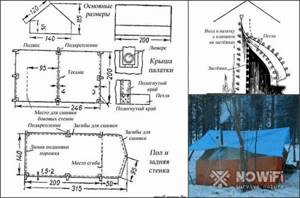
Figure 6. Main stages of making a homemade shelter
This is interesting: Tracking a hare in the snow
If you were unable to get waterproof fabric, you can sew a tent from regular tarpaulin and additionally make an awning from film that can be thrown over the shelter in case of heavy rain.
A tent is an indispensable thing for winter fishing
When planning winter fishing, it is necessary to provide for many situations in which lovers of this extreme recreation may find themselves.
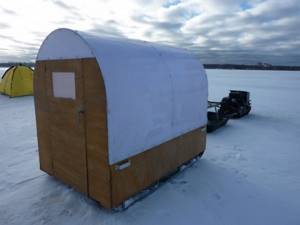
A self-made tent, as well as equipping it with necessary household items, will take into account all the individual needs of the creator, and thereby not only preserve his health, but also provide the necessary comfort and safety in difficult weather conditions.
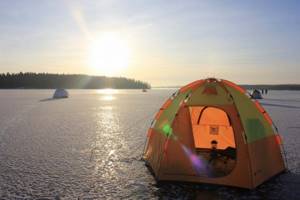
Drawings of a homemade winter tent
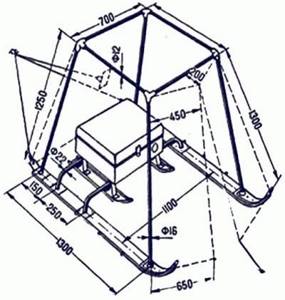
Judging by the drawings, the tent is mounted on skis, which simplifies its installation on ice. Regular tents require special fasteners. In addition, skis allow you to move the entire structure around the pond countless times. As a rule, winter fishing is not limited to one punched hole - there can be ten, or even more, and each hole has to be fished.
This is interesting: What does bleak bite on?
The only thing is that it is problematic to use it in the presence of strong wind, since it is mounted on skis, the wind will be able to move it across the pond on its own. In this case, you can get used to it and use the power of the wind to move it. The main thing is to drill the holes correctly.
DIY winter tent photo
Read here DIY ice drill: life hacks, drawings and tips for choosing a design. Assembly and use instructions (140 photos + video)
Help the project, share on social networks 

0

